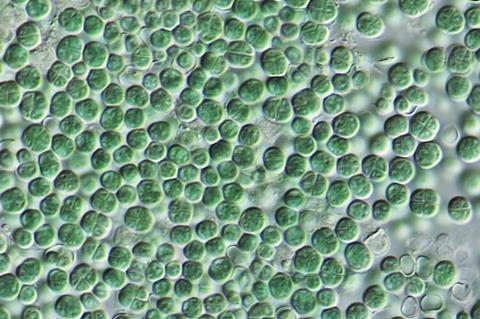Cyanobacteria began contributing oxygen to Earth’s mostly noxious atmosphere more than 2 billion years ago. The photosystem II protein complex now shared by various lineages of cyanobacteria, algae and land plants has served as a major site of oxygen production throughout the history of life on Earth ever since.

Ironically, receiving too much light can damage photosystem II and erode the photosynthetic efficiency of plants. Purdue University biochemists Steven McKenzie and Sujith Puthiyaveetil have gleaned new, long-hidden details about how photosystem II repairs itself. McKenzie and Puthiyaveetil’s findings have been published in the journal Plant Communications.
READ MORE: Cyanobacteria gene regulates growth of microbes that promote photosynthesis
READ MORE: Researchers throw new light on carboxysomes in key discovery that could boost photosynthesis
“The photosystem II splits water and extracts electrons and protons, leaving oxygen as a by-product. Photosystem II thereby powers life on Earth,” said Puthiyaveetil, associate professor of biochemistry. Even so, “it’s still fairly poorly understood how these huge protein complexes that use light energy to produce oxygen are able to be repaired and maintained so efficiently across different lineages of plants, algae and cyanobacteria.”
Photosynthetic efficiency
The long-term goal of the project is to learn how to engineer plants to have better photosynthetic efficiency, said McKenzie, a postdoctoral scholar in biochemistry.
“The repair of photosystem II is an energetically expensive process,” said McKenzie, who completed his PhD at Purdue in 2024. “You have to disassemble photosystem II, degrade the damaged proteins, resynthesize new proteins and reassemble new photosystems. That’s energetically costly to the chloroplast.”
The repair of photosystem II in chloroplasts — the sites of photosynthesis in plants and algae — is already fairly efficient, McKenzie said. “But you could make it more efficient by speeding up the repair process or making it less energy intensive.”
Repair cycle
Recent efforts to manipulate the photoprotective pathways of plant photosynthesis have led to increased photosynthetic efficiency in crop plants. Genetic engineering of different aspects of the photosystem II repair cycle similarly holds potential for improvement of photosynthetic efficiency.
Inhibiting the repair cycle can lower the efficiency of photosynthesis drastically, Puthiyaveetil said.
“This is a key process that’s happening all the time. Even in low light, photosystem II is turning over. In high light, the rate of damage and repair really goes up. But sometimes the rate of repair cannot keep up with the rate of damage, especially under a combination of high light and other stressors such as drought, salinity and high temperature. This leads to a light-induced loss of photosynthesis,” said Puthiyaveetil, who is also a member of Purdue’s Center for Plant Biology.
Sunny day damage
As photosystem II undertakes the formidable job of splitting water using energy from sunlight, it suffers photodamage. For every 10 million photons — light particles — absorbed by leaves, one photosystem II gets damaged. On a sunny day, a plant leaf intercepts as many as 10 quadrillion photons per second.
How this protein complex gets taken apart to remove and replace the damaged protein for maintaining efficient photosynthesis has long persisted as an unresolved question. Photosystem II is huge by molecular standards, consisting of around 25 protein subunits, a few metallic centers, and scores of chlorophylls and other pigment molecules.
The new Plant Communications paper shows how the chemical process of adding phosphate groups to proteins — “protein phosphorylation” — drives some of the photosystem II disassembly steps in Arabidopsis plants. Scientists have known since 1977 about the phosphorylation of photosystem II. What role it played in the photosystem II repair cycle, however, had remained unclear.
Key to disassembly
The Purdue scientists originally suspected that phosphorylation was solely responsible for photosystem II disassembly. Then McKenzie suggested that oxidative protein modification may also play a part.
“Steve thought that maybe the protein oxidative damage could also be a disassembly mechanism,” Puthiyaveetil said. Further experimentation revealed that oxidative protein damage serves as a key mechanism that helps drive photosystem II disassembly, especially at the later stages. “We were quite surprised by the extent of it. Full credit to Steve.”
Cyanobacteria, red and brown algae, and land plants all share the photosystem II repair mechanism, McKenzie said. What gave him the idea is that cyanobacteria and non-green algae lack photosystem II phosphorylation and yet are able to disassemble and repair their photosystems.
“We were interested to know whether there was an alternative mechanism that could be responsible for driving photosystem II disassembly,” McKenzie said. “That’s why we thought perhaps the damage to photosystem II itself could be driving disassembly of the complex.”
Two functions of phosphorylation
Phosphorylation seems to serve two functions. “It can drive disassembly, but also it could ensure a quality control mechanism for the repair,” Puthiyaveetil said. “We say that because once you disassemble the complex you have to repair the complex.” And plants don’t repair their photosystems under persistent high light. “They wait for the high light to go away. There’s some kind of molecular mechanism behind the delay between damage and repair.”
Then once light levels return to normal repair and reassembly of the damaged protein begin. “That’s the quality control,” Puthiyaveetil noted. “Maybe phosphorylation will prevent the degradation of damaged proteins until they have been dephosphorylated as dephosphorylation has been shown to be a prerequisite for degradation.”
In his experiments, McKenzie used genetically altered plants with varying levels of photosystem II phosphorylation. He also manipulated phosphorylation levels by altering light and the source of phosphate groups. By doing so, “we can see what changing the levels of phosphorylation on photosystem II do to the disassembly and repair cycle,” he said.
This research was funded by the U.S. Department of Energy and the USDA National Institute of Food and Agriculture.







No comments yet